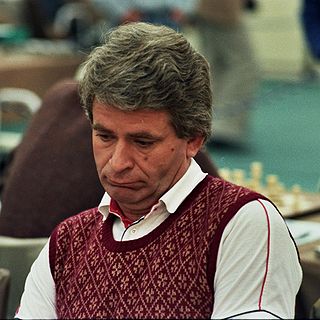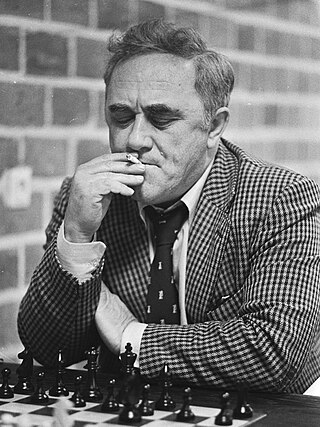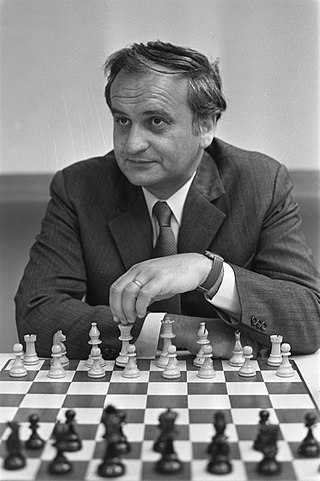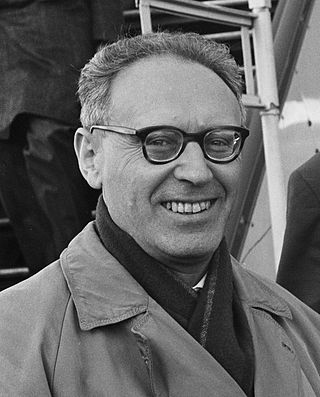
Boris Vasilievich Spassky is a Russian chess grandmaster who was the tenth World Chess Champion, holding the title from 1969 to 1972. Spassky played three world championship matches: he lost to Tigran Petrosian in 1966; defeated Petrosian in 1969 to become world champion; then lost to Bobby Fischer in a famous match in 1972.

Mikhail Nekhemyevich Tal was a Soviet-Latvian chess player and the eighth World Chess Champion. He is considered a creative genius and is widely regarded as one of the most influential players in chess history. Tal played in an attacking and daring combinatorial style. His play was known above all for improvisation and unpredictability. Vladislav Zubok said of him, "Every game for him was as inimitable and invaluable as a poem".

Paul Keres was an Estonian chess grandmaster and chess writer. He was among the world's top players from the mid-1930s to the mid-1960s, and narrowly missed a chance at a World Chess Championship match on five occasions. As Estonia was repeatedly invaded and occupied during World War II, Keres was forced by the circumstances to represent the Soviet Union and Nazi Germany (1941–44) in international tournaments.

Leonid Zakharovych Stein was a Soviet chess Grandmaster from Ukraine. He won three USSR Chess Championships in the 1960s, and was among the world's top ten players during that era.

Jørgen Bent Larsen was a Danish chess grandmaster and author. Known for his imaginative and unorthodox style of play, he was the second-strongest non-Soviet player, behind only Bobby Fischer, for much of the 1960s and 1970s. He is considered to be the strongest player born in Denmark and the strongest from Scandinavia until the emergence of Magnus Carlsen.

Wolfgang Unzicker was one of the strongest German chess Grandmasters from 1945 to about 1970. He decided against making chess his profession, choosing law instead. Unzicker was at times the world's strongest amateur chess player, and World Champion Anatoly Karpov called him the "world champion of amateurs".

Samuel Herman Reshevsky was a Polish chess prodigy and later a leading American chess grandmaster. He was a contender for the World Chess Championship from the mid-1930s to the mid-1960s: he tied for third place in the 1948 World Chess Championship tournament, and tied for second in the 1953 Candidates tournament. He was an eight-time winner of the US Chess Championship, tying him with Bobby Fischer for the all-time record.
A game of chess can end in a draw by agreement. A player may offer a draw at any stage of a game; if the opponent accepts, the game is a draw. In some competitions, draws by agreement are restricted; for example draw offers may be subject to the discretion of the arbiter, or may be forbidden before move 30 or 40, or even forbidden altogether. The majority of draws in chess are by agreement.

Efim Petrovich Geller was a Soviet chess player and world-class grandmaster at his peak. He won the Soviet Championship twice and was a Candidate for the World Championship on six occasions. He won four Ukrainian SSR Championship titles and shared first in the 1991 World Seniors' Championship, winning the title outright in 1992. His wife Oksana was a ballet dancer while his son Alexander was also a chess master. Geller was coach to World Champions Boris Spassky and Anatoly Karpov. He was also an author.

Lajos Portisch is a Hungarian chess Grandmaster, whose positional style earned him the nickname, the "Hungarian Botvinnik". One of the strongest non-Soviet players from the early 1960s into the late 1980s, he participated in twelve consecutive Interzonals from 1962 through 1993, qualifying for the World Chess Championship Candidates Cycle a total of eight times. Portisch set several all-time records in Chess Olympiads. In Hungarian Chess Championships, he either shared the title or won it outright a total of eight times. He won many strong international tournaments during his career. In 2004, Portisch was awarded the title of 'Nemzet Sportolója', Hungary's highest national sports achievement award.

Borislav Ivkov was a Serbian chess Grandmaster. He was a World championship candidate in 1965, and played in four more Interzonal tournaments, in 1967, 1970, 1973, and 1979.

At the World Chess Championship 1963, Tigran Petrosian narrowly qualified to challenge Mikhail Botvinnik for the World Chess Championship, and then won the match to become the ninth World Chess Champion. The cycle is particularly remembered for the controversy surrounding the Candidates' Tournament at Curaçao in 1962, which resulted in FIDE changing the format of the Candidates Tournament to a series of knockout matches.

A World Chess Championship was played between Tigran Petrosian and Boris Spassky in Moscow from April 9 to June 9, 1966. Petrosian won.

The 1969 World Chess Championship was played between Tigran Petrosian and Boris Spassky in Moscow from April 14 to June 17, 1969. This was the second consecutive time Petrosian and Spassky played for the world title. Spassky reversed the previous result; winning the world title and becoming the tenth World Chess Champion.
The San Antonio Church's Fried Chicken Inc. First International Chess Tournament was a chess competition held in San Antonio, Texas, from November 19 to December 11, 1972. Sponsored by fast food franchise Church's Chicken as a marketing strategy to promote the company and an attempt to capitalize on the rise of the game's popularity in the U.S, the tournament was regarded at the time the strongest chess tournament held in the country since 1924. The list of players invited included famous names like former world champion Tigran Petrosian, regular contenders to the world crown Svetozar Gligoric, Paul Keres and Bent Larsen, and some promising stars, among them Brazilian Henrique da Costa Mecking and future world champion Anatoly Karpov.












